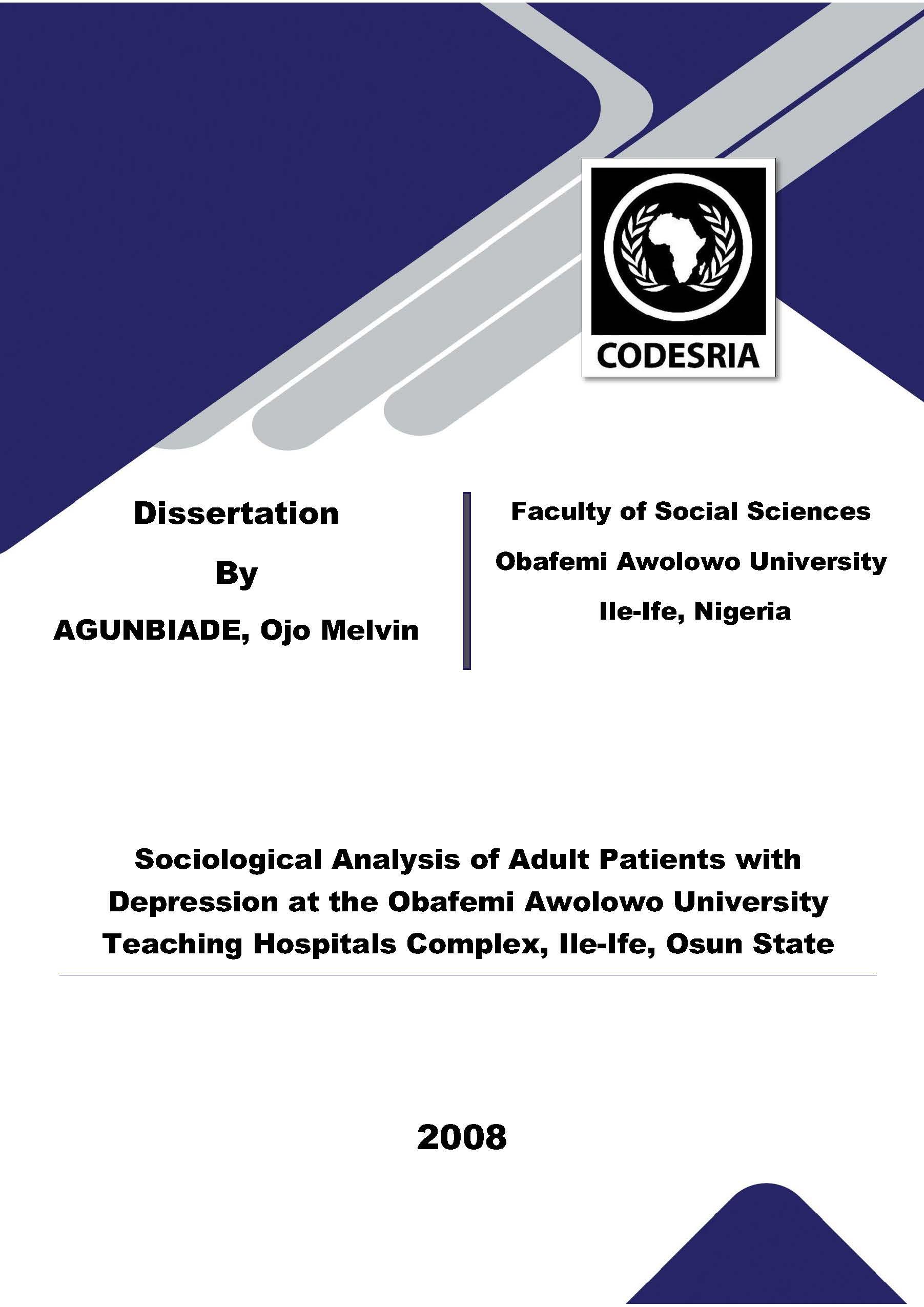Sociological Analysis of Adult Patients with Depression at the Obafemi Awolowo University Teaching Hospitals Complex, Ile-Ife, Osun State
Keywords:
Sociological, Analysis, Adult Patients, Depression, Obafemi Awolowo University, Hospitals Complex, Ile-Ife, Osun StateSynopsis
The study examined the influence of socio-economic factors (marital status, occupation and
religious affiliation) on the prevalence of depression. It also investigated patients’ perception
and knowledge of the illness and identified the coping mechanisms adopted by adult patients with
depression at the Obafemi Awolowo University Teaching Hospitals Complex (OAUTHC). This was with a
view to exploring the socio-cultural context of depressive disorders in the study area.
Data were obtained from primary and secondary sources. A Case-Control design was adopted. The study
population consisted of two categories of adult patients (18-60years): those with primary
depressive conditions and those without depression seeking treatment over a 5 year period
(2002-2007) at the OAUTHC. Based on the hospital records, 110 adult patients with depression and
309 adult patients without depressive conditions met the inclusion criteria. All the 110 adult
patients with depression were selected for the Case Group, while an equal number of 110 adult
patients were selected for the Control Group using a simple random sampling technique. A total of
220 copies of questionnaire were administered on the two categories of adult patients. In-depth
interviews were held with 14 psychiatric caregivers (3 Doctors and 11 Nurses) in the hospitals.
Also, case files of patients with depression were consulted for relevant secondary information.
Data were analysed using descriptive and inferential statistics.
The results showed that there were more young adults (18-40 years) in the Case Group (71.8%) than
the Control Group (51.3%). Also 58.6% of married female adults were in the Case Group compared to
the Control Group (41.4%); however, no significant relationship was found between marital status
and depression (χ² = 0.05, P >0.05).
Downloads
References
Acker, J., (1992). Gendered institutions: From sex roles to gendered institutions. Contemporary
Sociology, 21, 565-569.
Akintunde, O., (1982). Attitudes of civil servants in Ile-Ife towards the use of traditional
medicine. An unpublished Bachelor of Science Long Essay, Obafemi Awolowo University
Ile-Ife.
Alarape, A.I., Okurame, D.E., and Odum, N.B. (2001). Menopausal Status, Depression, and Life
Satisfaction among some Organisational Women. Ife Psychologia, .9, 2, 18-26.
American Psychiatric Association. (1994). Diagnostic and statistical manual of mental disorders
(4th edition.). Washington, DC: American Psychiatric Association.
American Psychological Association (1952). Diagnostic and statically manual of mental disorders.
Washington, DC: American Psychiatric Association.
American Psychological Association (1968). Diagnostic and statically manual of mental disorders
(2ⁿᵈ edition). Washington, DC: American Psychiatric Association.
American Psychological Association (1980). Diagnostic and statically manual of mental disorders
(3ʳᵈ edition). American Psychiatric, Washington, DC.
American Psychological Association (2000). Diagnostic and statically manual of mental disorders
(4ᵗʰ text revision). American Psychiatric, Washington, DC.
American Psychological Association (1987). Diagnostic and statically manual of mental disorders
(3ʳᵈ revised edition). American Psychiatric, Washington, DC.
Aseltine, R.H. and Kessler, R.C. (1993). Marital disruption and depression in a community
sample, Journal of Health and Social Behaviour, 34,237-251.
Baron, R.M., and Kenny D.A. (1986). The Moderator-mediator variable distinction in Social
Psychological Research: conceptual, strategic and statistical considerations. Journal of
Personality and Social Psychology, 51, 6, 1173-1182.
BBC News Report on Depression (2005). Retrieved December 20, 2005, from
http://news.bbc.co.uk/2/hi/health/492941.stm.
Becker and Maiman (1975). Sociobehavioural determinants of compliance with health and
medical care recommendations. Med. Care, 13: 10-24.
Bellenir, Karen (2002). Depression Source Book, First Edition, Omni graphics 615 Griswold
Street. Detroit, MI 48226.
Benazon, N. R. and Coyne (2000). Predicting negative spousal attitudes toward depressed
persons: A test of Coyne's Interpersonal Model. Journal of Abnormal Psychology, 109, 550-
Bhugra, D., and Mastrogianni (2004). Globalisation and mental disorders: Overview with
relation to depression. The British Journal of Psychiatry.184:10-24.
Bodeker, Gerard (2000). Planning for cost effective traditional health services. (Summary).
International Symposium on traditional medicine, 11-13 September. Global Initiative for
Traditional Systems of Health. United Kingdom
Bourguignon, E. (1976). The effectiveness of religious healing movements: A review of recent
literature. Transcultural Psychiatric Research Review 13:5-21, 1976.
Broadhead, J.C. and Abas, M.A. (1998). Life events, difficulties and depression among women
in an urban setting in Zimbabwe. Psychological Medicine, 28:29-38.
Brown, G.W., Harris, T.O., and Hepworth, C. (1995). Loss and depression: a patient and nonpatient
comparison, Psychological Medicine, 25: 7-21.
Cano, A., Christian- Herman, J.L., O ‘Leary, K.D., and Avery-Leaf, S. (2002). Antecedents and
consequences of negative marital stressors. Journal of Marital and Family Therapy,
: 145-151.
Cano, A. and O’Leary, K.D. (2000). Infidelity and Separation Precipitate major depressive
episodes and symptoms of non-specific depression and anxiety. Journal of Consulting and
Clinical Psychology, 68,774-781.
Cano A. and O ‘Leary, K.D. (2002). Humiliating marital events precipitate Major Depressive
Episodes and symptoms of non-specific depression and anxiety. Journal of Consulting and
Clinical Psychology, 76,561-720.
Cano, A., O ‘Leary K. Daniel, and Heinz Wanda (2004). Short-term consequences of severe
marital stressors. Journal of social and personal relationships, 21, 4:419-430.
Cano, A., Weisberg, J., and Gallager, H. (2000). Marital satisfaction and pain severity mediate
the satisfaction between negative spouse responses to pain and depressive symptoms in a
chronic pain patient sample. Pain Medicine, 1, 35-43.
Carver, C., Sheier, M., and Weintraub, J. (1989). Assessing coping strategies: A theoretically
based approach. Journal of Personality and Social Psychology, 56, 2,267-283.
Cassell, E.J. (1985). The Healer's Art. Cambridge, MA: MIT Press.
Christensen, A. and Pasch, L. (1993). The sequence of marital conflict. An analysis of seven
phases of marital conflict in distressed and non-distressed couples. Clinical Psychology
Review, 13, 1-14.
Christian- Herman, J.L., O’Leary, K.D., and Avery-Leaf, S. (2001). The impact of severe
negative events in marriage on depression. Journal of Social and Clinical Psychology, 20,
-40.






